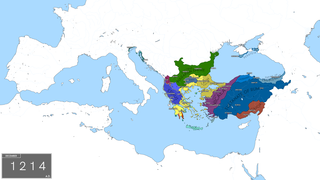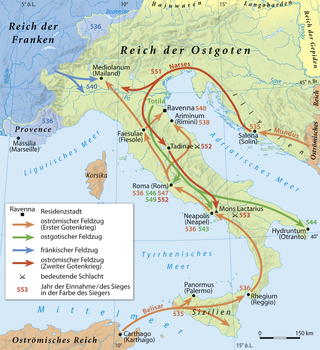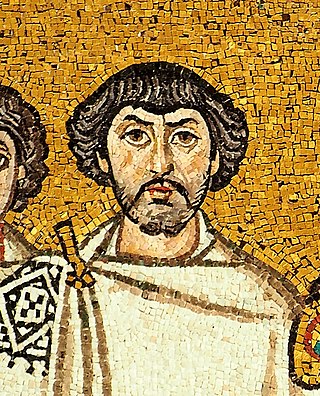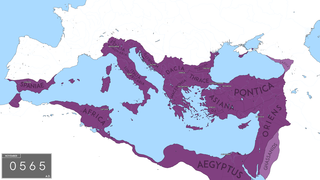The 540s decade ran from January 1, 540, to December 31, 549.

Year 546 (DXLVI) was a common year starting on Monday of the Julian calendar. The denomination 546 for this year has been used since the early medieval period, when the Anno Domini calendar era became the prevalent method in Europe for naming years.

Totila, original name Baduila, was the penultimate King of the Ostrogoths, reigning from 541 to 552 AD. A skilled military and political leader, Totila reversed the tide of the Gothic War, recovering by 543 almost all the territories in Italy that the Eastern Roman Empire had captured from his Kingdom in 540.

The Latin Empire, also referred to as the Latin Empire of Constantinople, was a feudal Crusader state founded by the leaders of the Fourth Crusade on lands captured from the Byzantine Empire. The Latin Empire was intended to replace the Byzantine Empire as the Western-recognized Roman Empire in the east, with a Catholic emperor enthroned in place of the Eastern Orthodox Roman emperors. The main objective of the Latin Empire was planned by Venice, which promoted the creation of this state for their self-benefit.

The Empire of Nicaea or the Nicene Empire was the largest of the three Byzantine Greek rump states founded by the aristocracy of the Byzantine Empire that fled when Constantinople was occupied by Western European and Venetian armed forces during the Fourth Crusade, a military event known as the Sack of Constantinople. Like the other Byzantine rump states that formed due to the 1204 fracturing of the empire, such as the Empire of Trebizond and the Despotate of Epirus, it was a continuation of the eastern half of the Roman Empire that survived well into the medieval period. A fourth state, known in historiography as the Latin Empire, was established by an army of Crusaders and the Republic of Venice after the capture of Constantinople and the surrounding environs.
This is an alphabetical index of people, places, things, and concepts related to or originating from the Byzantine Empire. Feel free to add more, and create missing pages. You can track changes to the articles included in this list from here.

The Gothic War between the Byzantine Empire during the reign of Emperor Justinian I and the Ostrogothic Kingdom of Italy took place from 535 to 554 in the Italian Peninsula, Dalmatia, Sardinia, Sicily and Corsica. It was one of the last of the many Gothic Wars against the Roman Empire. The war had its roots in the ambition of the Byzantine emperor Justinian I to recover the provinces of the former Western Roman Empire, which the Romans had lost to invading barbarian tribes in the previous century, during the Migration Period.

The Muslim conquest of Sicily began in June 827 and lasted until 902, when the last major Byzantine stronghold on the island, Taormina, fell. Isolated fortresses remained in Byzantine hands until 965, but the island was henceforth under Muslim rule until conquered in turn by the Normans in the 11th century.

The Palaiologan army refers to the military forces of the Byzantine Empire under the rule of the Palaiologos dynasty, from the late 13th century to its final collapse in the mid-15th century. The army was a direct continuation of the forces of the Empire of Nicaea, which itself was a fractured component of the formidable Komnenian army of the 12th century. Under the first Palaiologan emperor, Michael VIII, the army's role took an increasingly offensive role whilst the naval forces of the empire, weakened since the days of Andronikos I Komnenos, were boosted to include thousands of skilled sailors and some 80 ships. Due to the lack of land to support the army, the empire required the use of large numbers of mercenaries.

The Battle of Sena Gallica, was a naval battle fought off the Italian Adriatic coast in the autumn of 551 between an East Roman (Byzantine) and an Ostrogoth fleet, during the Gothic War (535–554). It marked the end of the Goths' brief bid to deny the seas to the Romans, and the beginning of the Byzantine resurgence in the war under the leadership of Narses.

Belisarius was a military commander of the Byzantine Empire under the emperor Justinian I. Belisarius was instrumental in the reconquest of much of the Mediterranean territory belonging to the former Western Roman Empire, which had been lost less than a century prior. Belisarius is considered one of the greatest military commanders in history and the greatest of all Byzantine generals.

The Byzantine Empire underwent a golden age under the Justinian dynasty, beginning in 518 AD with the accession of Justin I. Under the Justinian dynasty, particularly the reign of Justinian I, the empire reached its greatest territorial extent since the fall of its Western counterpart, reincorporating North Africa, southern Illyria, southern Spain, and Italy into the empire. The Justinian dynasty ended in 602 with the deposition of Maurice and the ascension of his successor, Phocas.

The city of Rome was besieged in AD 549–550 by the Ostrogoths, led by Totila, during a campaign to recapture Italy from the Byzantine Empire. After Totila imposed a blockade, soldiers from the city's garrison opened the gates to the Ostrogothic army. Many of Rome's male inhabitants were killed in the city or while attempting to flee, with the city's population declining from around one million inhabitants to only 30,000.
John, the nephew of the rebel Vitalian, was an Eastern Roman general under Justinian I, who was active in the Gothic War in Italy and against the Gepids in the western Balkans. He was married to Justina, the daughter of Justinian's cousin Germanus.
Indulf, also known as Gundulf, was a Byzantine mercenary who defected to the Ostrogoths and became a leader in their army in the last years of the Gothic War of 535–554.
Bessas was an Eastern Roman general of Gothic origin from Thrace, primarily known for his career in the wars of Justinian I. He distinguished himself against the Sassanid Persians in the Iberian War and under the command of Belisarius in the Gothic War, but after Belisarius' departure from Italy he failed to confront the resurgent Goths and was largely responsible for the loss of Rome in 546. Returning east in disgrace, despite his advanced age he was appointed as commander in the Lazic War. There he redeemed himself with the recapture of Petra, but his subsequent idleness led Justinian to dismiss him and exile him to Abasgia.

The Battle of the Straits was fought in early 965 between the fleets of the Byzantine Empire and the Fatimid Caliphate in the Straits of Messina. It resulted in a major Fatimid victory, and the final collapse of the attempt of Emperor Nikephoros II Phokas to recover Sicily from the Fatimids.

The siege of Taormina in 902 ended the conquest of the Byzantine city of Taormina, in northeastern Sicily, by the Aghlabids. The campaign was led by the deposed Aghlabid emir, Ibrahim II, as a form of armed pilgrimage and holy war. Ibrahim's forces defeated the Byzantine garrison in a hard-fought battle in front of the city walls, and laid siege to the city. Left unsupported by the Byzantine government, Taormina capitulated on 1 August. The population was massacred or sold into slavery. The fall of this last major Byzantine stronghold signalled the completion of the Muslim conquest of Sicily, which had been ongoing since the 820s, although some minor Byzantine outposts survived until the 960s.
A reason for the longevity of the Byzantine Empire is how they managed their foreign relations. The army and later its navy were the primary methods with the evolved traditions of the Roman Empire, however Byzantine diplomacy which eventuated with their many treaties was used extensively as well.













